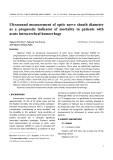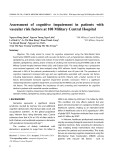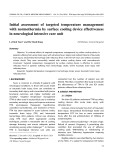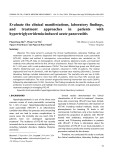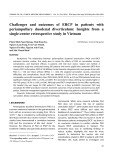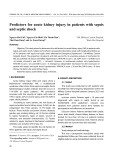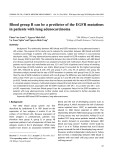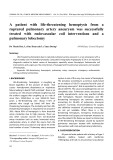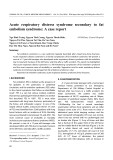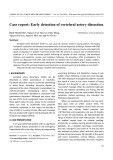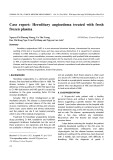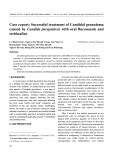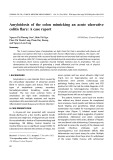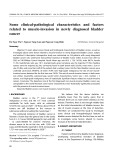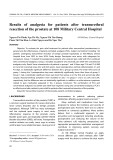Human enhancer of rudimentary is a molecular partner of PDIP46/SKAR, a protein interacting with DNA polymerase d and S6K1 and regulating cell growth Amelia Smyk1, Magdalena Szuminska1, Katarzyna A. Uniewicz1, Lee M. Graves2 and Piotr Kozlowski1
1 Institute of Biochemistry, Warsaw University, Warsaw, Poland 2 Department of Pharmacology, University of North Carolina at Chapel Hill, NC, USA
Keywords ER; POLDIP3; pyrimidine; RNA recognition motif; yeast two-hybrid system
Correspondence P. Kozlowski, Institute of Biochemistry, Warsaw University, Miecznikowa 1, 02-096 Warsaw, Poland Fax: +48 22 5543116 Tel: +48 22 5543108 E-mail: pkozlowski@biol.uw.edu.pl
Databases The nucleotide sequence reported in this paper has been submitted to the DDBJ ⁄ EMBL ⁄ GenBank databases with the accession number DQ887818. The DDBJ ⁄ EMBL ⁄ GenBank accession numbers: U66871 (ER), AL160111 and AL160112 (POLDIP3). The UniProtKB ⁄ SwissProt accession numbers: P84090 (ER), P05990 (CAD), Q91901 (DCoH ⁄ PCD), O00267 (SPT5), Q9Y5B0 (FCP1), Q9BY77 (PDIP46 ⁄ SKAR) and P23443 (S6K1).
Enhancer of rudimentary (ER) is a small protein that has a unique amino acid sequence and structure. Its highly conserved gene has been found in all eukaryotic kingdoms with the exception of fungi. ER was proposed to be involved in the metabolism of pyrimidines and was reported to act as a transcriptional repressor in a cell type-specific manner. To further elucidate ER functions, we performed the yeast two-hybrid screen of the human lung cDNA library for clones encoding proteins interacting with the human ER protein. The screen yielded polymerase d interacting protein 46 or S6K1 Aly ⁄ REF-like target (PDIP46 ⁄ SKAR), a protein possessing one RNA recognition motif (RRM) and being a protein partner of both the p50 sub- unit of DNA polymerase d and p70 ribosomal protein S6 kinase 1 (S6K1). This interaction was further confirmed in vitro by the glutathione S-trans- ferase-ER pull-down of a protein of 46 kDa from a nuclear extract from human cells which was identified as PDIP46 ⁄ SKAR by tandem mass spectrometry. The bipartite region of PDIP46 ⁄ SKAR interacting with ER comprising residues 274–421 encompasses the docking site for S6K1 within the RRM and two serines phosphorylated by S6K1. ER and both isoforms of PDIP46 ⁄ SKAR share the same nuclear localization in the mammalian cells and their genes display a ubiquitous pattern of expression in a variety of human tissues, so the interaction between ER and PDIP46 ⁄ SKAR has an opportunity to occur universally in mammalian cells. Because PDIP46 ⁄ SKAR is involved in the regulation of cell growth its interaction with ER may suggest some function for ER in that control.
(Received 25 April 2006, revised 18 August 2006, accepted 18 August 2006)
doi:10.1111/j.1742-4658.2006.05477.x
this gene has not been isolated so far [1–5]. Moreover, it seems to be absent in the sequenced genomes of Sac- charomyces cerevisiae and Schizosaccharomyces pombe.
The enhancer of rudimentary (ER) gene has been iden- tified in eukaryotic organisms ranging from protists to plants to humans with the exception of fungi, in which
Abbreviations CK2, casein kinase II; DCoH/PCD, dimerization cofactor of hepatocyte nuclear factor 1 (HNF1)/pterin-4a-carbinolamine dehydratase; EGFP, enhanced green fluorescent protein; ER, enhancer of rudimentary; FCP1, TFIIF-associating component of CTD phosphatase; GAL4, galactose utilization gene 4; GST, glutathione S-transferase; HNF1, hepatocyte nuclear factor 1; IPTG, isopropyl thio-b-D-galactoside; MEK1, mitogen- activated protein kinase or extracellular signal-regulated kinase 1; PDIP46, polymerase d interacting protein 46; RRM, RNA recognition motif; S6K1, S6 kinase 1; SKAR, S6K1 Aly ⁄ REF-like target; SP5, suppressor of Ty 5; X-gal, 5-bromo-4-chloroindol-3-yl b-D-galactoside.
FEBS Journal 273 (2006) 4728–4741 ª 2006 The Authors Journal compilation ª 2006 FEBS
4728
A. Smyk et al.
Enhancer of rudimentary interacts with PDIP46 ⁄ SKAR
Drosophila the severity of the wing truncation is r expression [11]. thought the level of to reflect Although the effects of the P element generated muta- tion in ER are due to a drastic reduction in the amounts of both of its transcripts, it does not seem that ER acts as a regulator of r as this mutation does not significantly affect the level of the r transcript in adult flies [1]. It was also excluded that ER is one of the genes for the enzymes in the biosynthesis or degra- dation of pyrimidines [1]. Rather, it was suggested that it may be involved in the regulation of the metabolism of pyrimidines [1]. The Drosophila ER contains two sites for CK2 that undergo phosphorylation in vitro resulting in a putative shift in the secondary structure of ER which suggests that CK2 may regulate the activ- ity of ER [2].
their
In the genomes of the species possessing ER no para- logs have been identified so far [1–5]. ER genes code for small proteins that usually consist of 100–105 amino acids [1–5]. However, in plants ER proteins have some additional amino acids at their N-termini [2,5]. Analysis of ER amino acid sequences has not shown the presence of any known protein motifs or domains that could reveal their possible biochemical or cellular function or their intracellular localization; only one or two putative casein kinase II (CK2) phos- phorylation sites have been identified within them [2]. Yet their comparisons have revealed that ER proteins are highly conserved, especially among the vertebrates [2]. The mammalian (human, Mus musculus) and amphibian (Xenopus laevis) ER proteins are fully iden- tical and differ from their counterpart in fish (Danio rerio) by a single, conservative amino acid substitution [2,4]. The former proteins and the Drosophila melano- gaster ER differ only in 26 amino acids, showing a identity to the Caenorhabditis 76% identity; elegans and Arabidopsis thaliana ER proteins is lower, 52% and 42%, respectively [2].
ER was first
enhancement
of
r mutants
repressor
The Xenopus ER was identified as one of the pro- teins interacting with dimerization cofactor of hepato- cyte nuclear factor 1 (HNF1)/pterin-4a-carbinolamine dehydratase (DCoH ⁄ PCD) by the use of the yeast two-hybrid system [4]. DCoH ⁄ PCD is a bifunctional protein. It serves as a dimerization cofactor of the HNF1 homeobox transcription factors which also enhances their transcriptional activity [12]. DCoH ⁄ PCD also acts as an enzyme, pterin-4a-carbinolamine dehydratase, which is involved in the regeneration of tetrahydrobiopterin, an essential cofactor of several metabolic reactions not directly related to the metabo- [13,14]. The Xenopus ER is lism of pyrimidines expressed ubiquitously in adult frogs [4]. The ER tran- script is also present in the egg and at an increased level during organogenesis; it was detected in tissues derived from the ectoderm such as the eyes, parts of the brain, the spinal cord and branchial arches [4]. The Xenopus ER expressed in HeLa cells was predomin- antly localized in the cytoplasm [4]. Because in the same cells, the Xenopus ER alone was found to inhibit the the DCoH ⁄ PCD-dependent HNF1a-mediated transcription from a corresponding reporter gene and the Xenopus ER fused to the galac- tose utilization gene 4 (GAL4) DNA binding domain was able to repress the activity of a GAL4 reporter construct, it was proposed that ER acts as a transcrip- [4]. Unlike ER, DCoH ⁄ PCD is tional expressed tissue specifically in adult frogs (mainly in the kidney and liver) [15]. Therefore, the existence of other proteins interacting with ER was predicted [4].
The human ER transcript was found in many nor- mal tissues, including fetal ones [3]. The level of the ER transcript in two nondividing mammalian cell lines examined, primary hepatocytes and adult liver was very low, whereas it was easily detected in rapidly pro- liferating cells of four different hepatoma cell lines [2].
identified in a genetic screen in D. melanogaster for the P element (paternal strain-spe- cific transposon) induced mutations that changed the phenotype of mutations in the rudimentary (r) gene [1]. The r gene encodes carbamoyl-phosphate synthase (glutamine-hydrolyzing) aspartate carbamoyl transfer- ase and dihydroorotase (CAD), a multifunctional three steps in the enzyme that catalyses the first de novo pathway of the biosynthesis of pyrimidines [6,7]. Mutations in r are manifested in a characteristic truncation of the wings [8]. This phenotype results from a depletion in pyrimidines because mutations in two other genes coding for the subsequent enzymatic activities in the pathway, dhod and r-l also lead to the truncated wings [9,10]. The performed screen brought a recessive hypomorphic mutation mapped to an unknown gene that enhanced the wing truncation phenotype of [1]. some hypomorphic Because in the wildtype r background the mutation did not display any mutant wing phenotype and the flies appeared otherwise normal, the gene was named enhancer of rudimentary [1]. There are two ER tran- scripts in Drosophila that differ only in the length of the 3¢ UTR caused by alternative polyadenylation; the shorter one is found in equal amounts in adult flies of both sexes, the longer one is found in the nurse cells of the ovaries and in the preblastoderm embryos [1]. After gastrulation, the maternal transcript disappears and the zygotic transcript and protein are found in a subset of cells expressing DmcycE, which encodes cyclin E, and undergoing DNA replication [2]. In
FEBS Journal 273 (2006) 4728–4741 ª 2006 The Authors Journal compilation ª 2006 FEBS
4729
A. Smyk et al.
Enhancer of rudimentary interacts with PDIP46 ⁄ SKAR
Results
Yeast two-hybrid screening
The human ER was found to be one of the proteins copurifying with suppressor of Ty 5 (SPT5), a tran- scription elongation factor, when an extract from cells expressing FLAG epitope-tagged SPT5 was subjected to FLAG antibody affinity chromatography [16]. In a similar approach, the human ER was reported to copurify with TFIIF-associating component of CTD phosphatase (FCP1), a phosphatase specific for the carboxy-terminal domain of the large subunit of RNA polymerase II; this interaction was also confirmed by coimmunoprecipitation [17]. It was proposed that ER might be involved in the regulation of transcription as a counteracting protein of FCP1 and SPT5, positive transcription elongation factors for RNA polym- erase II [17]. A 32 amino acid fragment of ER isolated from the swine small intestine, referred to as peptide 3910, also showed antibacterial activity [18]. Recently, the high-resolution crystal structures of the human and murine ER proteins were reported [5,19,20]. These studies demonstrated that ER folds into a single domain consisting of a four-stranded antiparallel b sheet with three amphipathic a helices situated on one face of the b sheet that does not have significant struc- tural homologs in databases. The studies also showed that ER can function as a homodimer through interac- tions between the b sheet regions and that phosphory- lation at the CK2 sites might disrupt its dimerization and potential interactions with other proteins.
two-hybrid system with the full-length The yeast human ER protein as a bait was employed. The cloned cDNA of the human ER gene was inserted into the bait plasmid, pHybLex ⁄ Zeo in frame with the LexA DNA binding domain coding sequence. The obtained con- struct (pHybLex ⁄ Zeo-ER) was transformed into the L40 yeast strain alone and together with the prey plas- mid, pYESTrp2, encoding the B42 transcriptional acti- vation domain. The resulting strains were tested for the transactivation of two reporter genes, HIS3 and lacZ exhibiting neither the capability to grow in the absence of histidine nor a detectable b-galactosidase activity (the His– LacZ– phenotype, for both plasmids in L40; Fig. 1). Thus, the ability of ER to nonspecifically trans- activate the reporter genes was excluded. Roughly one third of the human lung cDNA library in the pYESTrp2 plasmid with 5.95 · 106 independent clones was screened by transformation into the L40 strain expressing the bait. There were 364 histidine proto- trophs after a 6-day selection, of which 83 also dis- played b-galactosidase activity [yielded blue color in the 5-bromo-4-chloroindol-3-yl b-d-galactoside (X-gal) colony-lift filter assay]. Using PCR followed by agarose from the His+ gel electrophoresis, cDNA inserts LacZ+ transformants were sorted into groups. The
In plants, apart from the identification of ER in the Arabidopsis genome, ER was reported to be induced during programmed cell death in response to infection of soybean with pathogenic bacteria [2,21].
cell
Fig. 1. Interaction between ER and the truncated protein encoded by the partial clone of the POLDIP3 gene (the L7 insert) examined by the yeast two-hybrid system using lacZ and HIS3 as reporter genes. Yeasts L40 were transformed with the original bait plasmid, pHybLex ⁄ Zeo-ER and the empty prey plasmid, pYESTrp2 (1), the retrieved prey plasmid, pYESTrp2 with the L7 insert and the empty bait plasmid, pHybLex ⁄ Zeo (2), the retrieved prey plasmid, pYESTrp2 with the L7 insert and the original bait plasmid, pHyb- Lex ⁄ Zeo-ER (3) or the retrieved prey plasmid, pYESTrp2 with the L7 insert and the irrelevant bait plasmid, pHybLex ⁄ Zeo-Lamin (4). The b-galactosidase activity examined by the X-gal colony-lift filter assay is shown as a strong gray color of the lysed yeasts (A) and the positive result of the histidine prototrophy assay is shown as the capability of yeasts to grow on minimal medium lacking histi- dine (B).
We were interested in the regulation of the metabo- lism of pyrimidines [22], therefore we decided to use an ER-oriented approach to identify its protein inter- actors, hoping that it would aid in assigning a more specific role to ER in the cell. Employing the yeast two-hybrid system, we identified the PDIP46 ⁄ SKAR protein encoded by the polymerase (DNA-directed), delta interacting protein 3 (POLDIP3) gene as a bind- ing partner of the human ER. PDIP46 ⁄ SKAR had been reported to be an interacting partner of the p50 subunit of DNA polymerase d and S6K1 that regulates the region of growth [23,24]. A bipartite PDIP46 ⁄ SKAR necessary for interaction with ER encompassing the S6K1 binding and phosphorylation sites was mapped. In addition, the intracellular distri- bution of ER was revised from the predominantly cytoplasmic localization [4] to the nuclear one, and was compared with the localization of both isoforms of PDIP46 ⁄ SKAR. We also show highly accurate tissue expression profiles of ER and POLDIP3 in humans.
FEBS Journal 273 (2006) 4728–4741 ª 2006 The Authors Journal compilation ª 2006 FEBS
4730
A. Smyk et al.
Enhancer of rudimentary interacts with PDIP46 ⁄ SKAR
prey plasmid from each group of transformants was retrieved and the cDNA insert was sequenced. After characterization of the inserts by using the BLAST algorithm [25], one of them (L7) that turned out to be a partial clone of the poorly characterized human gene POLDIP3 was selected for the present study.
To determine the specificity of the interaction, the retrieved prey plasmid with the L7 insert was trans- formed into the L40 strain. The obtained strain (YL7) did not exhibit activity of the reporter genes (data not shown). Next, the YL7 strain was transformed with (i) the empty bait plasmid, pHybLex ⁄ Zeo, (ii) the original bait plasmid, pHybLex ⁄ Zeo-ER, or (iii) the irrelevant bait plasmid, pHybLex ⁄ Zeo-Lamin, and the obtained strains were again tested for the activity of the reporter genes. The interaction was specific, as only the YL7 strain expressing ER as a bait exhibited the His+ LacZ+ phenotype, whereas the YL7 strains expressing either the LexA DNA binding domain alone or this domain fused to lamin, were not able to grow on a medium lacking histidine and did not show the b-galactosidase activity (Fig. 1).
Fig. 2. Proteins encoded by the POLDIP3 gene and the L7 insert. (A) Schematic representation of both isoforms of the PDIP46 ⁄ SKAR protein encoded by POLDIP3 and the truncated form of PDIP ⁄ SKAR encoded by the L7 insert. The region corresponding to the RNA recognition motif (RRM) is shaded in gray and amino acids encoded by an extra exon present in the isoform 1 ⁄ a are represen- ted as the striped box. Numbering of the truncated protein encoded by the L7 insert is according to the isoform 1 ⁄ a. (B) Amino acid sequence of PDIP46(1) ⁄ SKAR(a). Amino acids encoded by an extra exon present in the isoform 1 ⁄ a are in bold. Amino acids of the RNA recognition motif are shaded in gray. Amino acids encoded by the L7 insert are underlined. Two serines (383 and 385) phosphoryl- ated by S6K1 are double underlined. The ends of the RRM on both panels are as in [24], however, according to PROSITE the RRM is shifted by three residues toward the C-terminus [280–351 in PDIP46(1) ⁄ SKAR(a)] [27].
beads but not with GST-coated glutathione-agarose beads nor glutathione-agarose beads alone (Fig. 3B).
There are at least two splicing variants of the human POLDIP3 gene encoding proteins of 421 amino acids with a molecular mass of 46 kDa and 392 amino acids with a molecular mass of 43 kDa, which differ only by an insertion of 29 amino acids in the middle of the protein. These proteins are also known either as PDIP46 (polymerase d interacting protein 46) isoform 1 and 2, respectively, or as SKAR (S6K1 Aly ⁄ REF- like target) isoform a and b, respectively [23,24]. The L7 cDNA insert was found to consist of 666 bp con- taining the 3¢ end of the POLDIP3 coding sequence (with the stop codon) and coded for 163 amino acids the C-terminus of both isoforms of present at PDIP46 ⁄ SKAR, the including the amino acids of RNA recognition motif (RRM) also known as the RNA binding domain (Fig. 2) [26].
Interaction of the human proteins ER and PDIP46/SKAR in vitro
the C-terminal
To further confirm the interaction between ER and PDIP46 ⁄ SKAR GST-tagged ER-coated glutathione- agarose beads or GST-coated glutathione-agarose beads were incubated with a nuclear extract obtained from human epithelial cells, HeLa S3. Among proteins specifically pulled down by the ER bait and separated by one-dimensional SDS ⁄ PAGE there was a band of a protein with electrophoretic mobility of approximately 46 kDa, which corresponds to the molecular mass of isoform 1 ⁄ a of PDIP46 ⁄ SKAR (Fig. 3C). The band of this protein was excised from a gel and after digestion with trypsin was subjected to tandem mass spectrome- try (MS ⁄ MS) analysis that revealed the presence of three peptide sequences derived from the PDIP46 ⁄ SKAR protein in the examined protein sample (Fig. 3D). One of these peptides, TIQVPQQK (resi- dues 148–155) overlaps the region encoded by the extra exon characteristic of isoform 1 ⁄ a of PDIP46 ⁄ SKAR.
interaction of the In order to confirm the physical human ER protein with PDIP46 ⁄ SKAR we performed the glutathione S-transferase (GST) pull-down assay using the GST-fusion protein of the L7 insert (the last sequence of 163 amino acids of PDIP46 ⁄ SKAR) bound to glutathione-agarose beads and the recombinant full-length ER protein with a FLAG epitope tag at its C-terminus (Fig. 3A). Western blot analysis with antibody raised against the FLAG epitope showed that ER was precipitated with GST- tagged PDIP46 ⁄ SKAR(L7)-coated glutathione-agarose
FEBS Journal 273 (2006) 4728–4741 ª 2006 The Authors Journal compilation ª 2006 FEBS
4731
A. Smyk et al.
Enhancer of rudimentary interacts with PDIP46 ⁄ SKAR
B
A
C
D
mammalian cells. The cloned cDNA of the human ER gene was introduced into the pEGFP-N1 plasmid in frame with the EGFP coding sequence. Because only the partial clone of the POLDIP3 gene coding for PDIP46 ⁄ SKAR was retrieved from the two-hybrid library (the L7 insert), cDNAs coding for both full- length isoforms of the PDIP46 ⁄ SKAR protein were cloned. The two cloned cDNAs were also introduced into the pEGFP-N1 plasmid. In individual experi- ments, the obtained constructs were transiently trans- fected into two different cell lines, HeLa, human epithelial cells, and NIH ⁄ 3T3, murine fibroblasts. Visualization of the fluorescent chimera proteins, ER, isoform 1 ⁄ a of PDIP46 ⁄ SKAR or isoform 2 ⁄ b of PDIP46 ⁄ SKAR fused to a C-terminal EGFP tag was performed in the living cells. The direct fluorescence microscopic observations revealed that all three pro- teins were undoubtedly localized in the nucleus in a very similar diffuse pattern that excluded the nucleoli, in both HeLa and NIH ⁄ 3T3 cells (Fig. 4A–C). In the same cells the mitogen-activated protein kinase or extracellular signal-regulated kinase 1 (MEK1) pro- tein fused to a C-terminal EGFP tag and expressed from the same vector was used as a control showing a diffuse cytoplasmic localization characteristic of this kinase (Fig. 4D) [28].
Comparison of the expression profiles of the human ER and POLDIP3 genes
Fig. 3. Interaction between ER and PDIP46 ⁄ SKAR examined by the GST pull-down assays. (A) Proteins used in the assay with recom- binant proteins expressed in E. coli and purified separated on a 12% SDS ⁄ polyacrylamide gel and stained with Coomassie brilliant blue. (B) Precipitates obtained after incubation of ER-FLAG with glutathione-agarose beads or protein-coated glutathione-agarose beads, as indicated, were analyzed by western blot with anti-FLAG antibody followed by the enhanced chemiluminescence reaction. Input, 1 ⁄ 20 of ER-FLAG used in the assay. (C) Proteins pulled down with GST-tagged ER-coated glutathione-agarose beads or GST-coated glutathione-agarose beads from a nuclear extract from HeLa S3 cells separated on a 10% SDS ⁄ polyacrylamide gel and stained with silver. The arrow indicates a protein of approximately 46 kDa pulled down with the GST-ER bait that was subjected to analysis by mass spectrometry. (D) The peptide sequences of PDIP46 ⁄ SKAR identified by tandem mass spectrometry analysis and their position in isoform 1 ⁄ a of PDIP46 ⁄ SKAR. The asterisk indicates the peptide identified by manual analysis of MS ⁄ MS spectra.
Comparison of the intracellular localizations of the human ER and PDIP46/SKAR proteins
The array of polyA+ RNA isolated from 61 different human adult tissues, seven human fetal tissues and eight human cancer cell lines that was normalized to eight different housekeeping genes was used to accu- rately determine tissue expression profiles of the human ER and POLDIP3 genes. High stringency hybridization with the 32P-labeled cloned human ER cDNA probe showed that ER is expressed in all tis- sues and cell lines examined (Fig. 5A). The level of the ER transcript showed a very modest variation across all polyA+ RNA samples and, in this respect, was similar to the pattern of the human housekeeping gene coding for ubiquitin (data provided by the array manufacturer, Clontech). In adults, the highest level of the ER transcript was observed in the pituitary gland and it was 2.5-fold higher than that in the peripheral blood leukocytes in which the lowest level of the tran- script was detected. In fetal tissues, the ER transcript was the most abundant in the lung, whereas in the brain its level was the lowest (2-fold difference).
localization of
After stripping,
the We examined the intracellular human ER and PDIP46 ⁄ SKAR proteins fused with in the enhanced green fluorescent protein (EGFP)
the array was reprobed for the POLDIP3 expression with the radiolabeled partial cDNA probe, which was unable to discriminate between
FEBS Journal 273 (2006) 4728–4741 ª 2006 The Authors Journal compilation ª 2006 FEBS
4732
A. Smyk et al.
Enhancer of rudimentary interacts with PDIP46 ⁄ SKAR
Fig. 4. Comparison of the intracellular local- ization of ER and PDIP46 ⁄ SKAR fused to EGFP in the mammalian cells. NIH ⁄ 3T3 cells (upper) and HeLa cells (lower) were transi- ently transfected with plasmids coding for ER-EGFP (A), PDIP46(1) ⁄ SKAR(a)-EGFP (B), PDIP46(2) ⁄ SKAR(b)-EGFP (C) or MEK1- EGFP used as a control (D) and their localization was determined by direct fluorescence of EGFP in living cells. Repre- sentative images obtained with a confocal laser scanning microscope are shown.
tissues,
the highest
level of
tissues,
and could be further split into two subregions. The larger one (subregion I) comprised residues 274–368 [PDIP46 ⁄ SKAR(D)] encompassing all amino acids of the RNA recognition motif (residues 277–348, Fig. 2) and the smaller one (subregion II) comprised residues 379–421 [PDIP46 ⁄ SKAR(I)] with an at least 10 amino acid gap between them suggesting a bipartite nature of the interface on the PDIP46 ⁄ SKAR side.
the alternative transcripts of the POLDIP3 gene. Simi- larly to ER, POLDIP3 is expressed in all tissues and cell lines examined and the level of expression shows a min- imal variation between the samples (Fig. 5B). Among the expression of POLDIP3 was the adult strongest in the testis and right cerebellum, and the weakest in the esophagus and left ventricle (2.2-fold dif- ference). In fetal the POLDIP3 transcript was in the kidney, whereas the low- est level was observed in the brain (1.7-fold difference).
Discussion
Yeast two-hybrid analysis of the interaction between the human proteins ER and PDIP46/ SKAR
A conserved and essential function still awaiting eluci- dation has been predicted for ER. ER was proposed to play a role in the regulation of the metabolism of pyrimidines because a mutation in ER augmented the wing truncation phenotype caused by mutations in r that codes for CAD, a multifunctional enzyme involved in the de novo biosynthesis of pyrimidines [1]. However, no protein partners in this context have been identified so far. In addition, ER seems to take part in the process of transcription. ER was shown to bind and inhibit DCoH ⁄ PCD, a cell-specific positive cofac- tor for the HNF1 homeobox transcription factors [4]. ER was also reported to copurify with SPT5 and FCP1, proteins involved in the elongation phase of the transcription driven by RNA polymerase II [16,17]. Finally, because ER is expressed at an increased level in rapidly dividing cells and ER is phosphorylated by CK2, a kinase required at the G1 ⁄ S and G2 ⁄ M transi- tions, a role for ER in the progression through the cell cycle was suggested [2].
274–421
In an attempt to understand the role of ER in the cell, we decided to screen the human proteome for
In order to analyze the details of the interaction between the human ER and PDIP46 ⁄ SKAR proteins a series of constructs (A–K) in the pYESTrp2 plasmid coding for fragments of the truncated form of the PDIP46 ⁄ SKAR protein encoded by the L7 insert was generated. In sub- sequent experiments, each construct was transformed into the L40 yeast strain expressing the full-length human ER protein. The interaction between the gener- ated fragments of PDIP46 ⁄ SKAR and ER was analyzed by the yeast two-hybrid assay employing the histidine prototrophy and b-galactosidase assays as earlier. The positive and negative species are summarized in Fig. 6 as ‘+’ and ‘–’, respectively. The 148 amino acid long region of PDIP46 ⁄ SKAR that was found to interact with ER constitutes the C-terminal part of PDIP46 ⁄ [PDIP46 ⁄ residues SKAR comprising SKAR(K); all position numbering according to isoform 1 ⁄ a of PDIP46 ⁄ SKAR]. This region is not continuous
FEBS Journal 273 (2006) 4728–4741 ª 2006 The Authors Journal compilation ª 2006 FEBS
4733
A. Smyk et al.
Enhancer of rudimentary interacts with PDIP46 ⁄ SKAR
A
PDIP46 ⁄ SKAR was found to interact with ER. The binding was specific, as only interaction between PDIP46 ⁄ SKAR and ER was positive, whereas neither PDIP46 ⁄ SKAR nor ER was able to activate reporter genes alone or in the presence of negative control pro- teins. Recombinant PDIP46 ⁄ SKAR and ER were able to bind each other in vitro in the GST pull-down assay and ER fused to GST pulled down a protein of 46 kDa from a nuclear extract that was identified as PDIP46 ⁄ SKAR by tandem mass spectrometry, thus providing independent confirmations of the interaction identified by the yeast two-hybrid assay.
B
C
the expression profiles of
the ER and Fig. 5. Comparison of POLDIP3 genes. Array of 76 polyA+ RNA samples isolated from various human adult and fetal tissues and cancer cell lines was hybridized with the radiolabeled ER cDNA probe (A) and after stripping again with the radiolabeled POLDIP3 cDNA probe (B). The used POLDIP3 probe detects both POLDIP3 transcripts. The tissue origin and position of the examined polyA+ RNAs are shown in (C).
Here, we also address the issue of the intracellular localization of ER. The Xenopus ER was predomin- antly localized in the cytoplasm with only minute amounts in the nucleus, whereas DCoH ⁄ PCD was pre- sent in both the cytoplasm and nucleus, in agreement with the involvement of its dehydratase activity in the regeneration of tetrahydrobiopterin in the cytoplasm and the involvement of its dimerization activity for HNF1 in the nucleus [4]. It was, however, the nuclear aspect of the DCoH ⁄ PCD activity that was inhibited by ER [4]. Similarly, SPT5 and FCP1 are nuclear pro- teins [29,30]. The difference in the intracellular local- ization between ER and its molecular partners makes the predominant localization of ER in the cytoplasm questionable unless the observed traces of ER in the nucleus could indeed exert its role in this compartment and the pool of ER in the cytoplasm would be devoted to other functions. Contrary to the study on the Xen- opus ER, we have found that the human ER predom- inantly localizes to the nucleus of mammalian cells, including HeLa cells used in that study [4]. It should be noted that this observation is in accordance with the localization of all known molecular partners of ER, DCoH ⁄ PCD, SPT5 and FCP1 [4,29,30]. ER con- tains no obvious nuclear localization signal, however, its small size (approximately 12 kDa) might allow it to enter the nucleus by passive diffusion through the nuc- lear pores [31]. We do not know the reasons for the discrepancy between the studies but it is not due to the fact that the ER proteins from two different species, human and Xenopus were used, because they are iden- tical [4]. One of the possible explanations is that differ- ent tags and consequently methods were employed for their visualization. The Xenopus ER was His-tagged and detected by indirect immunofluorescence in meth- anol-fixed cells [4], whereas in the present study the human ER was EGFP-tagged and direct fluorescence detection in living cells was performed.
In the present
in validating the results of
study, molecular partners of ER. employing the yeast two-hybrid screening and using the human ER as bait, the C-terminal fragment of
The revised intracellular localization of ER is instru- mental the performed screen. Both isoforms of PDIP46 ⁄ SKAR are also
FEBS Journal 273 (2006) 4728–4741 ª 2006 The Authors Journal compilation ª 2006 FEBS
4734
A. Smyk et al.
Enhancer of rudimentary interacts with PDIP46 ⁄ SKAR
Fig. 6. Identification of the PDIP46 ⁄ SKAR region interacting with ER using the yeast two-hybrid assay. Yeasts L40 expressing the full-length ER from the original bait plasmid, pHybLex ⁄ Zeo-ER were transformed with a series of the pYESTrp2-based plasmids coding for fragments of the truncated form of the PDIP46 ⁄ SKAR protein encoded by the L7 insert [PDIP46 ⁄ SKAR(A-K)] and the b-galactosidase X-gal colony-lift fil- ter and histidine prototrophy assays were performed. Results are shown as ‘+’ and ‘–’ in the presence (both tests were positive) and absence (both tests were negative) of the interaction, respectively. The RNA recognition motif (RRM) is shaded in gray. Two serines (383 and 385) phosphorylated by S6K1 are indicated. Numbering is according to isoform 1 ⁄ a of PDIP46 ⁄ SKAR. The dotted lines indicate the ends of the two subregions capable of interacting with ER individually.
for the screened cDNA library, DCoH ⁄ PCD and the DCoH ⁄ PCD transcript are hardly detected [12,15].
lines. Therefore,
localized in the same cell compartment as ER, the nuc- leus, in a pattern that is hardly distinguishable from that of ER, thereby arguing in favor of the possibility of the interaction between ER and PDIP46 ⁄ SKAR in the cell. Furthermore, both genes, ER and POLDIP3, coding for PDIP46 ⁄ SKAR are expressed in the same set of human tissues and cell it is conceivable that ER and PDIP46 ⁄ SKAR can really meet and interact in numerous if not all human tissues because both genes exhibit the expression pattern char- acteristic of a housekeeping gene.
the only putative
PDIP46 ⁄ SKAR is
[4],
its
PDIP46 was first identified in the yeast two-hybrid assay designed to find molecular partners of the p50 subunit of DNA polymerase d [23]. No further data on this interaction and the possible role of PDIP46 in processes in which this polymerase takes part have been reported so far. The same protein was also iden- tified in a similar approach as a binding partner of p70 ribosomal protein S6 kinase 1, S6K1 [24]. Sequence analysis of PDIP46 revealed the presence of the RNA recognition motif (RRM) in both its iso- forms showing the highest homology to the Aly ⁄ REF family of RNA binding proteins so it was named SKAR for S6K1 Aly ⁄ REF-like target. S6K1 binds PDIP46 ⁄ SKAR within the RRM (amino acids 277– 348) and phosphorylates two serines at positions 383 and 385 (Fig. 2). Interestingly, we have found that the bipartite region of PDIP46 ⁄ SKAR interacting with ER (amino acids 274–421) encompasses both the RRM (subregion I) and two serines phosphorylated by S6K1 (subregion II) (Fig. 6). The significance of this observation is not clear at the present time, however, the interaction of is a plausible hypothesis
that
interactor brought by the performed screen whose interaction with ER has been validated so far. Evaluation of the others is in progress and the results will be published elsewhere. None of them turned out to be an already known molecular partner of ER (data not shown). As the only protein far as DCoH ⁄ PCD is concerned, whose interaction with ER has been a subject of a more detailed study so far lack can be explained, at least in part, by its highly tissue-specific expression. Both in Xenopus and mouse, DCoH ⁄ PCD is expressed in the kidney and liver mainly; while in the lung, the tissue that was a source of polyA+ RNA
FEBS Journal 273 (2006) 4728–4741 ª 2006 The Authors Journal compilation ª 2006 FEBS
4735
A. Smyk et al.
Enhancer of rudimentary interacts with PDIP46 ⁄ SKAR
the first ATG and stop codons) were obtained using total RNA from HeLa cells, AMV reverse transcriptase and gene-specific primers from 3¢ UTRs of these genes to syn- thesize the first strand followed by PCR amplifications with a high-fidelity DNA polymerase, Pfx (Invitrogen, Carlsbad, CA, USA) and pairs of gene-specific primers from the beginning and end of their coding sequences, based on the records from the DDBJ ⁄ EMBL ⁄ GenBank databases (accession numbers U66871, AL160111 and AL160112; Table 1). All three PCR products coding for 104 amino acids (ER), 421 amino acids (isoform 1 ⁄ a of PDIP46 ⁄ SKAR) and 392 amino acids (isoform 2 ⁄ b of PDIP46 ⁄ SKAR) after adding 3¢ A overhangs with Taq DNA polym- erase were inserted into the pCR2.1 plasmid (Invitrogen), transformed into the bacterial host strain Escherichia coli XL1 Blue MRF¢ and their fidelity was verified by nucleo- tide sequencing. the For
(Invitrogen) pHybLex ⁄ Zeo
and pGEX-4T1 ⁄ PDIP46 ⁄ SKAR(L7)
into BamHI of
individual cells
[8].
If
PDIP46 ⁄ SKAR with ER could block the PDIP46 ⁄ SKAR phosphorylation by S6K1. S6K1 is involved in the cell and organism growth control; mice with a knockout in S6K1 display the small mouse phenotype; a decrease in the size of the whole organism, and over- expression of S6K1 in mammalian cells results in the increased cell size [32,33]. PDIP46 ⁄ SKAR seems to be involved in the same processes because an RNAi knockdown of PDIP46 ⁄ SKAR resulted in the smaller cell size [24]. PDIP46 ⁄ SKAR is a nuclear protein and based on its homology to the Aly ⁄ REF family of proteins it was proposed that PDIP46 ⁄ SKAR as Aly ⁄ REF proteins could be involved in the coupling of transcription, premRNA splicing and transport of mRNA from the nucleus to cytoplasm to ‘govern the biogenesis of transcripts in response to S6K1 activa- tion, ultimately leading to changes in cell growth’ [24]. PDIP46 ⁄ SKAR is so far the only identified substrate of S6K1 that has been shown to influence cell size. Our finding that ER is a molecular partner of PDIP46 ⁄ SKAR and that interaction has an opportun- ity to occur universally in the mammalian cells raises a question about the role for ER in the cell growth control. This intriguing possibility is currently under investigation but it is already worth pointing out that ER itself does not seem to be another substrate of S6K1 as it contains no consensus sequence for this kinase (R ⁄ KxRxxS ⁄ Tx) [34]. ER, however, connects PDIP46 ⁄ SKAR with two molecular partners of ER, SPT5 and FCP1 which also play roles in coupling transcription to premRNA processing [35]. It is tempt- ing to propose that ER could be a novel cog in a machine from ‘gene expression factories’ [35]. Another molecular partner of ER, DCoH ⁄ PCD is also involved in transcription, however, it seems to be restricted to some tissues and no satisfactory evidence has been found that DCoH ⁄ PCD interacts with components of the general transcriptional machinery [12]. Finally, it should be noted in this context that the truncated wings in the Drosophila r mutants display a reduction in total number of cells per wing and a reduction in the area of indeed ER is involved in the cell growth control a mutation in ER could add to the effects of an r mutation leading to the enhancement of the wing truncation with no direct influence on the metabolism of pyrimidines.
Experimental procedures
cDNA cloning and DNA constructs
FEBS Journal 273 (2006) 4728–4741 ª 2006 The Authors Journal compilation ª 2006 FEBS
4736
following plasmid constructs all necessary restriction sites and a FLAG epitope tag were added and the unnecessary codons were removed during PCR amplif- ications by Pfx DNA polymerase, using the pCR2.1 plasmid harboring the suitable cDNA as a template and gene-specific primers (Table 1). Cloning was performed according to standard procedures [36] and the fidelity of the constructs was confirmed by restriction digestions and nucleotide sequencing. pHybLex ⁄ Zeo-ER was obtained by subcloning the ER cDNA (without the first ATG codon into EcoRI and XhoI sites and with the stop codon) of in-frame with LexA. pQE30 ⁄ ER-FLAG was generated by inserting the ER cDNA (without the first ATG codon and with codons for the FLAG epitope tag amino acids (DYKDDDDK) at the C-terminus followed by the stop codon) into BamHI and HindIII sites of pQE30 (Qiagen, Hilden, Germany) in-frame with 6· His. pEGFP-N1 ⁄ ER was constructed by inserting the ER cDNA (with the first ATG codon and without the stop codon) into HindIII and BamHI sites of pEGFP-N1 (Clontech, Palo Alto, CA, USA) in-frame with EGFP. pGEX- 4T1 ⁄ ER were generated by subcloning the L7 cDNA insert (with the stop codon) and the ER cDNA (without the first ATG codon and with the stop codon), respect- and NotI sites ively, pGEX-4T1 in-frame with GST. (Amersham, Little Chalfont, UK) pEGFP-N1 ⁄ PDIP46(1) ⁄ SKAR(a) pEGFP-N1 ⁄ and PDIP46(2) ⁄ SKAR(b) were obtained by subcloning the POLDIP3 cDNAs (with the first ATG codon and without the stop codon) into PstI site of pEGFP-N1 in-frame with EGFP. A series of pYESTrp2 ⁄ PDIP46 ⁄ SKAR(A–K) plas- mids was generated by subcloning the tested fragments of the L7 cDNA insert (with the stop codon) into BamHI and NotI sites of pYESTrp2 (Invitrogen) in-frame with B42. For pEGFP-N1 ⁄ MEK1 the rat MEK1 cDNA was amplified (with the first ATG codon and without the stop codon) using the pAX142-MEK1(WT) plasmid [37] as a cDNAs of the human genes, ER and POLDIP3 (both iso- forms) corresponding to their coding sequences (including
A. Smyk et al.
Enhancer of rudimentary interacts with PDIP46 ⁄ SKAR
Table 1. Primer sets for construction of plasmids used in this study.
Primer set
Plasmid
pCR2.1 ⁄ ER
pCR2.1 ⁄ PDIP46(1) ⁄ SKAR(a)
pCR2.1 ⁄ PDIP46(2) ⁄ SKAR(b)
pHybLex ⁄ Zeo-ER
pQE30 ⁄ ER-FLAG
pGEX-4T1 ⁄ ER
pGEX-4T1 ⁄ PDIP46 ⁄ SKAR(L7)
pEGFP-N1 ⁄ ER
pEGFP-N1 ⁄ PDIP46(1) ⁄ SKAR(a)
pEGFP-N1 ⁄ PDIP46(2) ⁄ SKAR(b)
pEGFP-N1 ⁄ MEK1
pYESTrp2 ⁄ PDIP46 ⁄ SKAR(A)
pYESTrp2 ⁄ PDIP46 ⁄ SKAR(B)
pYESTrp2 ⁄ PDIP46 ⁄ SKAR(C)
pYESTrp2 ⁄ PDIP46 ⁄ SKAR(D)
pYESTrp2 ⁄ PDIP46 ⁄ SKAR(E)
pYESTrp2 ⁄ PDIP46 ⁄ SKAR(F)
pYESTrp2 ⁄ PDIP46 ⁄ SKAR(G)
pYESTrp2 ⁄ PDIP46 ⁄ SKAR(H)
pYESTrp2 ⁄ PDIP46 ⁄ SKAR(I)
pYESTrp2 ⁄ PDIP46 ⁄ SKAR(J)
pYESTrp2 ⁄ PDIP46 ⁄ SKAR(K)
ATTTCATCTAATACAGTC GCGGGATCCACGATGTCTCACACCATTTTGC GCGGAATTCTTATTTCCCAGCCTGTTGGGCCTG CTTCTGGCTGCCTCACTCC GCGCGATATCGCAAGATGGCGGACATCTCCCTGG CTCAAAGCTTGATTTTGAATTCTGTG CTTCTGGCTGCCTCACTCC GCGCGATATCGCAAGATGGCGGACATCTCCCTGG CTCAAAGCTTGATTTTGAATTCTGTG GCGGAATTCTCTCACACCATTTTGCTGGT GCGCTCGAGTTATTTCCCAGCCTGTTGGGCCTG GCGGGATCCCACACCATTTTGCTGGTACA GCGAAGCTTTTATTTGTCATCGTCATCCTTGTAGTCTTTCCCAGCCTGTTGGGCCTG GCGGGATCCCACACCATTTTGCTGGTACA ATAAGAATGCGGCCGCCTATTTCCCAGCCTGTTGGGCCTG GCGGGATCCAACAAGGAAGAACCCCCC ATAAGAATGCGGCCGCTCAAAGCTTGATTTTGAATTCTG GCGAAGCTTCACGATGTCTCACACCATTT GCGGGATCCCGTTTCCCAGCCTGTTGGGCCT AAACTGCAGGATGGCGGACATCTCCCTGGAC AAACTGCAGAAGCTTGATTTTGAATTCTGT AAACTGCAGGATGGCGGACATCTCCCTGGAC AAACTGCAGAAGCTTGATTTTGAATTCTGT GCGAAGCTTCACGATGCCCAAGAAGAAGCCGACGCC GCGGGATCCCGGATGCTGGCAGCGTGGGTTGG GCGGGATCCAACAAGGAAGAACCCCCC ATAAGAATGCGGCCGCTCAAGGCAGCTCGCTCTCCTTTTT GCGGGATCCCTCAGCCCATTGGAAGGCACC ATAAGAATGCGGCCGCTCAAGGCAGCTCGCTCTCCTTTTT GCGGGATCCGTGAATAATCTGCACCCTCGA ATAAGAATGCGGCCGCTCAAGGCAGCTCGCTCTCCTTTTT GCGGGATCCCTCAGCCCATTGGAAGGCACC ATAAGAATGCGGCCGCTCAGCTGTCACTCAGCCGCAGCAG GCGGGATCCAACAAGGAAGAACCCCCC ATAAGAATGCGGCCGCTCAGTCTGAGGTGATAACATTCCC GCGGGATCCCTGGACGGGCAGCCGATGAAG ATAAGAATGCGGCCGCTCAAAGCTTGATTTTGAATTCTGT GCGGGATCCCAGCCCATCCTGCTGCGGCTG ATAAGAATGCGGCCGCTCAAAGCTTGATTTTGAATTCTGT GCGGGATCCCAGCCCATCCTGCTGCGGCTG ATAAGAATGCGGCCGCTCAGGGCTGCGTGGTCACAGAGGC GCGGGATCCCGCAGGGTGAACTCTGCCTCC ATAAGAATGCGGCCGCTCAAAGCTTGATTTTGAATTCTGT GCGGGATCCCCCCCTGCCGAAGTGGACCCT ATAAGAATGCGGCCGCTCAAAGCTTGATTTTGAATTCTGT GCGGGATCCCTCAGCCCATTGGAAGGCACC ATAAGAATGCGGCCGCTCAAAGCTTGATTTTGAATTCTGT
template and was inserted into HindIII and BamHI sites of pEGFP-N1 in-frame with EGFP.
Yeast two-hybrid screening
FEBS Journal 273 (2006) 4728–4741 ª 2006 The Authors Journal compilation ª 2006 FEBS
4737
resistance to zeocin was transformed into the yeast strain L40 [MATa his3D200 trp1-901 leu2-3112 ade2 LYS2::(4- lexAop-HIS3) URA3::(8lexAop-lacZ) GAL4]. Five independ- ent zeocine-resistant transformants expressed the chimeric protein LexA-ER at the same level [checked in crude lysates by western blotting by using the anti-(LexA) rabbit polyclo- nal antibody] and displayed no activation of HIS3 and lacZ The Hybrid Hunter yeast two-hybrid system from Invitrogen was employed. The pHybLex ⁄ Zeo-ER plasmid conferring
A. Smyk et al.
Enhancer of rudimentary interacts with PDIP46 ⁄ SKAR
reporter genes (no growth on a minimal medium lacking histidine and lack of the b-galactosidase activity in the colony-lift filter assay [38], respectively). A randomly chosen transformant displaying neither HIS3 nor lacZ activity after introducing the empty prey plasmid, pYESTrp2 was used further as a bait strain.
10% (v ⁄ v) glycerol; 1% (v ⁄ v) Triton X-100; 2 mm EDTA; 0.1 mm phenylmethanesulfonyl fluoride]. Following incuba- tion, beads were pelleted and washed four times with 1 mL of binding buffer and twice with 1 mL of NaCl ⁄ Pi and boiled in sample loading buffer. Protein samples were resolved on a 15% SDS ⁄ polyacrylamide gel and electro- blotted to a poly(vinylidene difluoride) membrane (Bio- Rad, Hercules, CA, USA). The membrane was incubated with the anti-FLAG epitope M2 monoclonal antibody (dilution 1 : 10000, Sigma) followed by an incubation with the horseradish peroxidase-conjugated goat antimouse sec- ondary antibody (dilution 1 : 2000; Santa Cruz, Santa Cruz, CA, USA). The bound antibody was visualized using the enhanced chemiluminescence reaction (Amersham).
GST pull-down from a nuclear extract
The human lung cDNA expression library in pYESTrp2 (5.95 · 106 independent clones, Invitrogen #A213-01) was transformed into the bait strain according to the manu- facturer’s recommended protocol with the efficiency of 2.2 · 106 tryptophan prototrophs. Using primers specific for the prey plasmid (included in the Hybrid Hunter kit), cDNA inserts from the His+ LacZ+ transformants were amplified by PCR, subjected to a 2% (w ⁄ v) agarose gel electrophor- esis and sorted into groups based on their sizes. Nucleotide sequence of the cDNA insert from each group was estab- lished and compared with the sequences from the public databases of the National Center for Biotechnology Infor- mation. The prey plasmid with one of the cDNA inserts, L7 [pYESTrp2 ⁄ PDIP46 ⁄ SKAR(L7), DDBJ ⁄ EMBL ⁄ GenBank accession number DQ887818] was retransformed into yeast L40 alone and together with pHybLex ⁄ Zeo, pHybLex ⁄ Zeo- ER or pHybLex ⁄ Zeo-Lamin (included in the Hybrid Hunter kit) to verify the specificity of the interaction.
Production and purification of recombinant proteins
Human HeLa S3 cells were grown as a suspension culture in Dulbecco’s modified Eagle’s medium (DMEM) with 10% (v ⁄ v) fetal bovine serum and antibiotics (100 UÆmL)1 penicillin and 100 lgÆmL)1 streptomycin) in a glass bottle on top of a magnetic stirrer in a humidified 5% carbon dioxide atmosphere at 37 (cid:2)C to the density of 1.3 · 106 cells per mL. One point two millilitres of the nuclear extract from 1.3 · 108 cells were prepared as described in [39] with a minor modification. Namely, proteins were extracted from nuclei with the P2 buffer supplemented with 420 mm NaCl and 1% (v ⁄ v) Triton X-100. GST-ER-coated beads or GST-coated beads (50 lL of the 50% slurry each) were incubated with the obtained nuclear extract (12 mg of in a final volume of 12 mL of binding total protein) (20 mm NaCl; 20 mm Tris ⁄ HCl, pH 7.4; 1 mm buffer dithiothreitol; 1 mm phenylmethanesulfonyl fluoride; 100· diluted protease inhibitor cocktail from Sigma) at 4 (cid:2)C overnight with gentle rotation. After washing twice with 12 mL of binding buffer 1 ⁄ 10 of bound protein was resolved on a 10% SDS ⁄ polyacrylamide gel and stained with silver [40].
Mass spectrometry
The pQE30 ⁄ ER-FLAG plasmid was transformed into E. coli XL1 Blue MRF¢ and production of ER-FLAG was induced at A600 of 0.7 [0.5 mm isopropyl thio-b-d-galacto- side (IPTG), 3 h, 37 (cid:2)C]. The pGEX-4T1 and pGEX- 4T1 ⁄ PDIP46 ⁄ SKAR(L7) plasmids were transformed into E. coli BL21(DE3) and expression of proteins was induced at A600 of 0.9–1.0 (1 mm IPTG, 4 h, 37 (cid:2)C). The pGEX- 4T1 ⁄ ER plasmid was introduced into E. coli BL21(DE3) and production of GST-ER was induced at A600 of 0.8 (0.1 mm IPTG, 3 h, 37 (cid:2)C). Cells were harvested by centrif- ugation, resuspended in lysis buffer recommended by the resin supplier and lysed by sonication. ER-FLAG was puri- fied using Ni-nitrilotriacetic acid resin (Qiagen) under native conditions according to the manufacturer’s protocol while GST-, GST-PDIP46 ⁄ SKAR(L7)- or GST-ER-coated beads were purified using glutathione-agarose as suggested by the supplier (Sigma, St Louis, MO, USA). All purified proteins were analyzed by SDS ⁄ PAGE followed by staining with Coomassie brilliant blue, showing near homogeneity.
GST pull-down assay with recombinant proteins
FEBS Journal 273 (2006) 4728–4741 ª 2006 The Authors Journal compilation ª 2006 FEBS
4738
A protein band was excised from a gel and analyzed by tandem mass spectrometry at Laboratory of Mass Spectr- ometry, Institute of Biochemistry and Biophysics PAS, Warsaw, Poland. Briefly, after reduction and alkylation by dithiothreitol and iodoacetamide, respectively, the protein was in-gel digested with trypsin [42]. The resulting pep- tides were analyzed on a nano-HPLC-ESI-LTQ-FT-ICR platform (a Finnigan LTQ FT hybrid mass spectrometer; Thermo, Waltham, MA, USA) using collision-induced dissociation for ion fragmentation. For protein identifica- tion MS ⁄ MS spectra were searched against the NCBInr database by using the mascot algorithm (Matrix Science, London, UK) [41] supplemented by manual analysis of spectra. For the GST pull-down assay, GST-PDIP46 ⁄ SKAR(L7)- coated beads, GST-coated beads or beads alone (20 lL of the 50% slurry each) were incubated for 2 h at 4 (cid:2)C with gentle rotation with ER-FLAG in a final volume of 1 mL of binding buffer [137 mm NaCl; 20 mm Tris ⁄ HCl, pH 7.5;
A. Smyk et al.
Enhancer of rudimentary interacts with PDIP46 ⁄ SKAR
Acknowledgements
Mammalian cell transfections and EGFP visualization
We thank Dr A. Czubaty for advice on the GST pull- down from a nuclear extract, Drs M. Dadlez and J. Debski for help with the mass spectrometry analysis, and Drs S. Bartoszewski, R. Derlacz and J. Fronk for critical reading of the manuscript. This work was supported by grant 6P04A04121 from the State Committee for Scientific Research (KBN) in Poland (to P.K.).
References
pEGFP-N1 ⁄ ER,
1 Wojcik E, Murphy AM, Fares H, Dang-Vu K &
Tsubota SI (1994) Enhancer of rudimentary p1, e(r)p1, a highly conserved enhancer of the rudimentary gene. Genetics 138, 1163–1170. 2 Gelsthorpe M, Pulumati M, McCallum C, Dang-Vu K
& Tsubota SI (1997) The putative cell cycle gene, enhan- cer of rudimentary, encodes a highly conserved protein found in plants and animals. Gene 186, 189–195.
3 Isomura M, Okui K, Fujiwara T, Shin S & Nakamura Y (1996) Cloning and mapping of a novel human cDNA homologous to DROER, the enhancer of the Drosophila melanogaster rudimentary gene. Genomics 32, 125–127. 4 Pogge von Strandmann E, Senkel S & Ryffel GU (2001)
Human HeLa cells were maintained in Dulbecco’s modified Eagle’s medium with 10% (v ⁄ v) fetal bovine serum and anti- biotics (100 UÆmL)1 penicillin and 100 lgÆmL)1 streptomy- cin) on plates in a humidified 5% carbon dioxide atmosphere at 37 (cid:2)C. For murine NIH ⁄ 3T3 cells DMEM was supple- mented with 10% (v ⁄ v) calf serum instead of fetal bovine serum. For chimeric protein expression and visualization, cells were seeded onto a 60 mm plate with a glass coverslip on the bottom 24 h prior to transfection and transfected with the pEGFP-N1 ⁄ PDIP46(1) ⁄ SKAR(a), pEGFP-N1 ⁄ PDIP46(2) ⁄ SKAR(b) or pEGFP-N1 ⁄ MEK1 plasmids using Lipofectamine Reagent according to the manufacturer’s suggested protocol (Invitrogen). Briefly, a mixture of 2 lg of the plasmid DNA and 8 lL of Lipofecta- mine in 2 mL of antibiotic- and serum-free DMEM was placed on cells at 30–40% confluence and incubated for 5 h at 37 (cid:2)C. After that time, the medium was replaced with regular DMEM. Two days later, coverslips with transfected cells were rinsed briefly with NaCl ⁄ Pi (with calcium and mag- inverted onto microscope slides and cells were nesium), immediately viewed on a confocal laser scanning microscope (an LSM510 unit coupled to an Axiovert 100M inverted microscope equipped with a Plan-Apochromat 63· ⁄ 1.4 Oil DIC objective; Zeiss, Jena, Germany) using the 488 nm exci- tation line of an argon laser and a BP505–550 nm band pass filter for detecting green fluorescence. ERH (enhancer of rudimentary homologue), a con- served factor identical between frog and human, is a transcriptional repressor. Biol Chem 382, 1379–1385. 5 Wan C, Tempel W, Liu ZJ, Wang BC & Rose RB
Array hybridizations with cDNA probes
(2005) Structure of the conserved transcriptional repres- sor enhancer of rudimentary homolog. Biochemistry 44, 5017–5023.
6 Jones ME (1980) Pyrimidine nucleotide biosynthesis in animals: genes, enzymes, and regulation of UMP bio- synthesis. Annu Rev Biochem 49, 253–279.
7 Evans DR & Guy HI (2004) Mammalian pyrimidine biosynthesis: fresh insights into an ancient pathway. J Biol Chem 279, 33035–33038. 8 Fausto-Sterling A & Hsieh L (1976) Studies on the
female-sterile mutant rudimentary of Drosophila melano- gaster. I. An analysis of the rudimentary wing pheno- type. Dev Biol 51, 269–281. 9 Porter LA & Rawls JM Jr (1984) The Dhod locus of
Drosophila: mutations and interrelationships with other loci controlling de novo pyrimidine biosynthesis. Mol Gen Genet 193, 27–32.
10 Lastowski DM & Falk DR (1980) Characterization of an autosomal rudimentary-shaped wing mutation in Drosophila melanogaster that affects pyrimidine synth- esis. Genetics 96, 471–478. 11 Tsubota SI & Fristrom JW (1981) Genetic and
FEBS Journal 273 (2006) 4728–4741 ª 2006 The Authors Journal compilation ª 2006 FEBS
4739
biochemical properties of revertants at the r locus in Drosophila melanogaster. Mol Gen Genet 183, 270–276. The human multiple tissue expression array from Clontech (#7775-1) was hybridized with two radiolabeled human cDNA probes. The cloned ER cDNA was labeled using the Megaprime labeling system (Amersham), purified from the unincorporated [32P]dATP[aP] (Amersham) with a QIA- quick nucleotide removal kit (Qiagen). High stringency hybridization was carried out in a rotation hybridization oven at 65 (cid:2)C overnight. Denatured human C0t1 DNA (Roche, Mannheim, Germany), sheared salmon testis DNA (Sigma) and 1.5 · 107 c.p.m. of the radiolabeled probe were added to PerfectHyb Plus hybridization buffer (Sigma). The membrane was washed at 65 (cid:2)C four times for 20 min with 2· NaCl ⁄ Cit, 1% SDS and twice for 10 min with 0.5· NaCl ⁄ Cit, 0.1% SDS and exposed for three days to an X-ray film with an intensifying screen at )70 (cid:2)C. Stripping of the membrane was performed according to the manufac- turer’s instructions. After assuring of the positive result of the stripping procedure by another exposure to an X-ray film, the array was reprobed with the labeled 237 bp frag- ment of POLDIP3 corresponding to amino acids 280–358 of isoform 1 ⁄ a of PDIP46 ⁄ SKAR as above. The autoradio- grams were digitized and the signal intensities were quanti- tated using the quantity one software (Bio-Rad).
A. Smyk et al.
Enhancer of rudimentary interacts with PDIP46 ⁄ SKAR
carbamoyl phosphate synthetase by MAP kinase. Nature 403, 328–332.
12 Mendel DB, Khavari PA, Conley PB, Graves MK, Hansen LP, Admon A & Crabtree GR (1991) Characterization of a cofactor that regulates dimerization of a mammalian homeodomain protein. Science 254, 1762–1767.
23 Liu L, Rodriguez-Belmonte EM, Mazloum N, Xie B & Lee MYWT (2003) Identification of a novel protein, PDIP38, that interacts with the p50 subunit of DNA polymerase d and proliferating cell nuclear antigen. J Biol Chem 278, 10041–10047. 24 Richardson CJ, Broenstrup M, Fingar DC, Julich K,
13 Citron BA, Davis MD, Milstien S, Gutierrez J, Mendel DB, Crabtree GR & Kaufman S (1992) Identity of 4a-carbinolamine dehydratase, a component of the phenylalanine hydroxylation system, and DCoH, a transregulator of homeodomain proteins. Proc Natl Acad Sci USA 89, 11891–11894. Ballif BA, Gygi S & Blenis J (2004) SKAR is a specific target of S6 kinase 1 in cell growth control. Curr Biol 14, 1540–1549.
14 Thony B, Auerbach G & Blau N (2000) Tetrahydro- biopterin biosynthesis, regeneration and functions. Biochem J 347, 1–16.
15 Pogge von Strandmann E & Ryffel GU (1995) Develop- mental expression of the maternal protein XDCoH, the dimerization cofactor of the homeoprotein LFB1 (HNF1). Development 121, 1217–1226. 25 Altschul SF, Madden TL, Schaffer AA, Zhang J, Zhang Z, Miller W & Lipman DJ (1997) Gapped BLAST and PSI-BLAST: a new generation of protein database search programs. Nucleic Acids Res 25, 3389–3402. 26 Burd CG & Dreyfuss G (1994) Conserved structures and diversity of functions of RNA-binding proteins. Science 265, 615–621. 16 Kwak YT, Guo J, Prajapati S, Park KJ, Surabhi RM,
27 Hulo N, Sigrist CJA, Le Saux V, Langendijk-Genevaux PS, Bordoli L, Gattiker A, De Castro E, Bucher P & Bairoch A (2004) Recent improvements to the PROSITE database. Nucleic Acids Res 32, D134–D137. Miller B, Gehrig P & Gaynor RB (2003) Methylation of SPT5 regulates its interaction with RNA polymerase II and transcriptional elongation properties. Mol Cell 11, 1055–1066. 28 Lenormand P, Sardet C, Pages G, L’Allemain G,
Brunet A & Pouyssegur J (1993) Growth factors induce nuclear translocation of MAP kinases (p42mapk and p44mapk) but not of their activator MAP kinase kinase (p45mapkk) in fibroblasts. J Cell Biol 122, 1079–1088.
17 Amente S, Napolitano G, Licciardo P, Monti M, Pucci P, Lania L & Majello B (2005) Identification of proteins interacting with the RNAPII FCP1 phosphatase: FCP1 forms a complex with arginine methyltransferase PRMT5 and it is a substrate for PRMT5-mediated methylation. FEBS Lett 579, 683–689. 18 Agerberth B, Boman A, Andersson M, Jornvall H, 29 Stachora AA, Schafer RE, Pohlmeier M, Maier G & Ponstingl H (1997) Human Supt5h protein, a putative modulator of chromatin structure, is reversibly phos- phorylated in mitosis. FEBS Lett 409, 74–78.
Mutt V & Boman HG (1993) Isolation of three antibac- terial peptides from pig intestine: gastric inhibitory poly- peptide (7–42), diazepam-binding inhibitor (32–86) and a novel factor, peptide 3910. Eur J Biochem 216, 623– 629. 30 Licciardo P, Ruggiero L, Lania L & Majello B (2001) Transcription activation by targeted recruitment of the RNA polymerase II CTD phosphatase FCP1. Nucleic Acids Res 29, 3539–3545. 19 Arai R, Kukimoto-Niino M, Uda-Tochio H, Morita S,
31 Suntharalingam M & Wente SR (2003) Peering through the pore: nuclear pore complex structure, assembly, and function. Dev Cell 4, 775–789.
Uchikubo-Kamo T, Akasaka R, Etou Y, Hayashizaki Y, Kigawa T, Terada T, Shirouzu M & Yokoyama S (2005) Crystal structure of an enhancer of rudimentary homolog (ERH) at 2.1 A˚ resolution. Protein Sci 14, 1888–1893. 32 Shima H, Pende M, Chen Y, Fumagalli S, Thomas G & Kozma SC (1998) Disruption of the p70 s6k ⁄ p85 s6k gene reveals a small mouse phenotype and a new func- tional S6 kinase. EMBO J 17, 6649–6659. 33 Fingar DC, Salama S, Tsou C, Harlow E & Blenis J
(2002) Mammalian cell size is controlled by mTOR and its downstream targets S6K1 and 4EBP1 ⁄ eIF4E. Genes Dev 16, 1472–1487. 20 Li H, Inoue M, Yabuki T, Aoki M, Seki E, Matsuda T, Nunokawa E, Motoda Y, Kobayashi A, Terada T, Shirouzu M, Koshiba S, Lin YJ, Guntert P, Suzuki H, Hayashizaki Y, Kigawa T & Yokoyama S (2005) Solu- tion structure of the mouse enhancer of rudimentary protein reveals a novel fold. J Biomol NMR 32, 329–334. 21 Seehaus K & Tenhaken R (1998) Cloning of genes by
mRNA differential display induced during the hypersensitive reaction of soybean after inoculation with Pseudomonas syringae pv. Glycinea. Plant Mol Biol 38, 1225–1234. 22 Graves LM, Guy HI, Kozlowski P, Huang M,
FEBS Journal 273 (2006) 4728–4741 ª 2006 The Authors Journal compilation ª 2006 FEBS
4740
34 Leighton IA, Dalby KN, Caudwell FB, Cohen PTW & Cohen P (1995) Comparison of the specificities of p70, S6 kinase and MAPKAP kinase-1 identifies a relatively specific substrate for p70, S6 kinase: the N-terminal kinase domain of MAPKAP kinase-1 is essential for peptide phosphorylation. FEBS Lett 375, 289–293. 35 Maniatis T & Reed R (2002) An extensive network of coupling among gene expression machines. Nature 416, 499–506. Lazarowski E, Pope RM, Collins MA, Dahlstrand EN, Earp HS & 3rd & Evans DR (2000) Regulation of
A. Smyk et al.
Enhancer of rudimentary interacts with PDIP46 ⁄ SKAR
39 Czubaty A, Girstun A, Kowalska-Loth B, Trzcinska
36 Sambrook J, Fritsch EF & Maniatis T (1989) Molecular Cloning: a Laboratory Manual, 2nd edn. Cold Spring Harbor Laboratory Press, Cold Spring Harbor, NY. 37 Whitehead IP, Lambert QT, Glaven JA, Abe K, AM, Purta E, Winczura A, Grajkowski W & Staron K (2005) Proteomic analysis of complexes formed by human topoisomerase I. Biochim Biophys Acta 1749, 133–141. 40 Shevchenko A, Wilm M, Vorm O & Mann M (1996)
Rossman KL, Mahon GM, Trzaskos JM, Kay R, Der Campbell SL & CJ (1999) Dependence of Dbl and Dbs transformation on MEK and NF-jB activation. Mol Cell Biol 19, 7759–7770.
FEBS Journal 273 (2006) 4728–4741 ª 2006 The Authors Journal compilation ª 2006 FEBS
4741
38 Breeden L & Nasmyth K (1985) Regulation of the yeast HO gene. Cold Spring Harb Symp Quant Biol 50, 643– 650. Mass spectrometric sequencing of proteins from silver- stained polyacrylamide gels. Anal Chem 68, 850–858. 41 Perkins DN, Pappin DJC, Creasy DM & Cottrell JS (1999) Probability-based protein identification by searching sequence databases using mass spectrometry data. Electrophoresis 20, 3551–3567.




